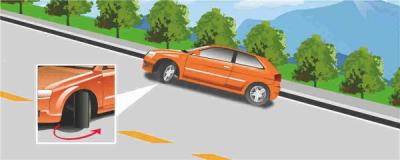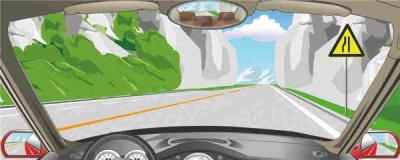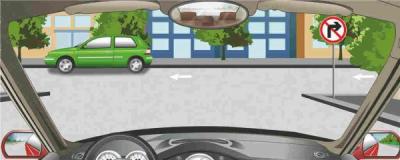1、When parking temporarily in this situation, motor vehicle drivers are allowed to turn the steering wheel left to avoid sliding.

A、Right
B、Wrong
Answer:A
2、The sign on the right warns of a guarded railway intersection ahead.

A、Right
B、Wrong
Answer:B
3、Mr Ran drove his car from 6am until 11 am without rest, falling down a steep 85-meter ridge at one side of a highway 1 km from Xunan Road in Xuahan County,killing 13 people and injuring 9. Which of the following law-breaking acts did Mr Ran commit?
A、Speeding
B、Driving not in accordance with the traffic markings
C、Exceeding carrying capacity
D、Fatigued driving
Answer:D
4、Motor vehicle drivers may make a U-turn in the broken line area as long as it will not affect the normal traffic flow.

A、Right
B、Wrong
Answer:A
5、What should the driver do to follow other motor vehicles on a mountain road?
A、Closely follow the vehicle in front
B、Increase the safety distance
C、Reduce the vertical distance between vehicles
D、Try to overtake the vehicle in front as soon as possible
Answer:B
6、After setting off from a roadside, motor vehicle drivers should watch both sides of the road, turn left and drive into the normal lane slowly.
A、Right
B、Wrong
Answer:A
7、When a fast-moving vehicle is likely to collide with the vehicle in front, what should the driver do?
A、Brake to reduce speed first, and then steer to evade
B、Turn the steering wheel quickly to the left side to evade
C、Turn the steering wheel quickly to the right side to evade
D、Steer to evade first, and then brake to reduce speed
Answer:A
8、How should the driver use vehicle lights when the motor vehicle enters this intersection?

A、Turn on the right-turn indicator
B、Turn on the hazard lamps
C、No need to turn on any indicators
D、Turn on the left indicator
Answer:C
9、When driving on a muddy road, what should drivers do if the wheels spin and slide?
A、Cover the ground under the wheels with gravels
B、Change to a high gear and speed out
C、Cover the ground under the driving wheels with gravels
D、Violently turn the steering wheel and suddenly leed up
Answer:C
10、Which one of the following measures is correct when a motor vehicle intends to overtake but the vehicle infront refuses to yield?
A、Use a long-sounding horn
B、Follow the vehicle in front while turning high-beam
C、Wait for it to yield while keeping a safe distance
D、Use high-beam and low-beam alternatively
Answer:C
11、The sign on the right warns of a widened left-hand road ahead.

A、Right
B、Wrong
Answer:B
12、The motor vehicle should slow down and pass slowly in this situation.

A、Right
B、Wrong
Answer:A
13、When driving a motor vehicle equipped with power steering, the driver should firmly hold the steering wheel and drive slowly if he/she suddenly finds that steering is difficult.
A、Right
B、Wrong
Answer:B
14、The sign on the right indicates that overtaking is allowed on the section ahead.

A、Right
B、Wrong
Answer:B
15、The sign on the right indicates that turning right is not permitted at the intersection ahead.

A、Right
B、Wrong
Answer:A
16、How will the adhesive force of road change when speed increases on a damp and slippery road?
A、Increase sharply
B、increase gradually
C、decrease sharply
D、No change
Answer:C
17、The main reason for this accident is that the pedestrian crossed the street in front of the motor vehicle.

A、Right
B、Wrong
Answer:B
18、As shown in this picture, the vehicles intending to turn left are allowed to drive into the left-turn waiting area directly to wait for the green light.

A、Right
B、Wrong
Answer:B
19、The sign on the right side warns of crosswind on the mountain pass ahead.

A、Right
B、Wrong
Answer:A
20、When a motor vehicle moves through water, the driver should try to maintain a constant speed and sufficient power and pass through without stopping.
A、Right
B、Wrong
Answer:A